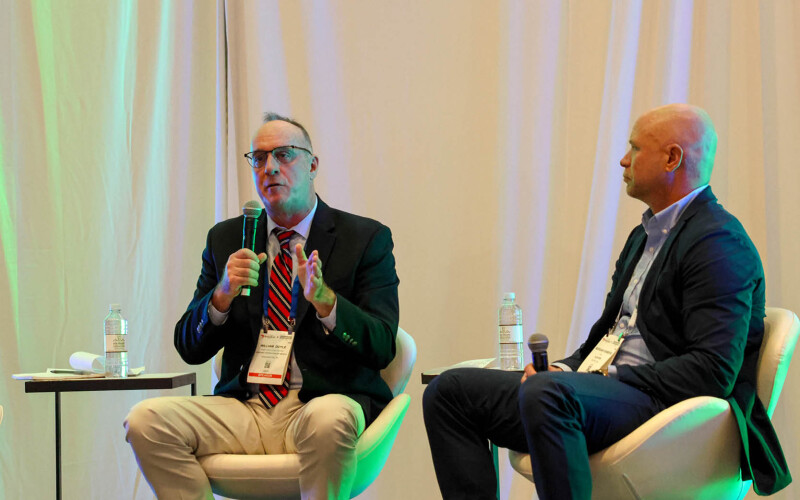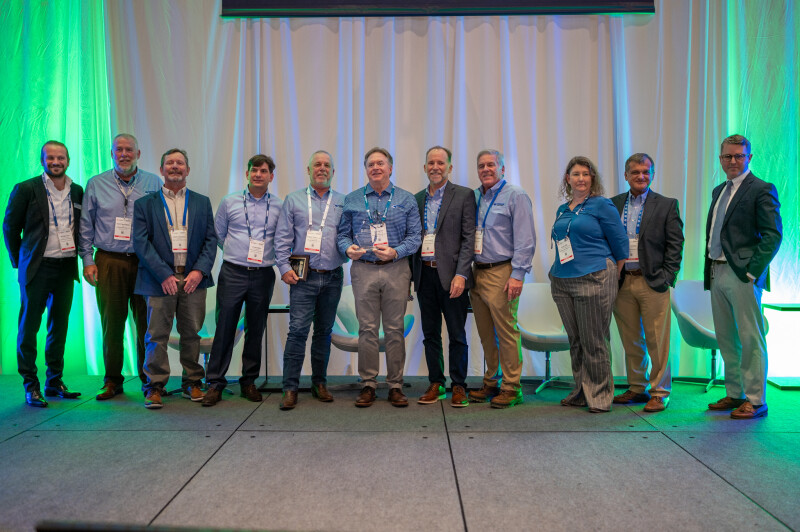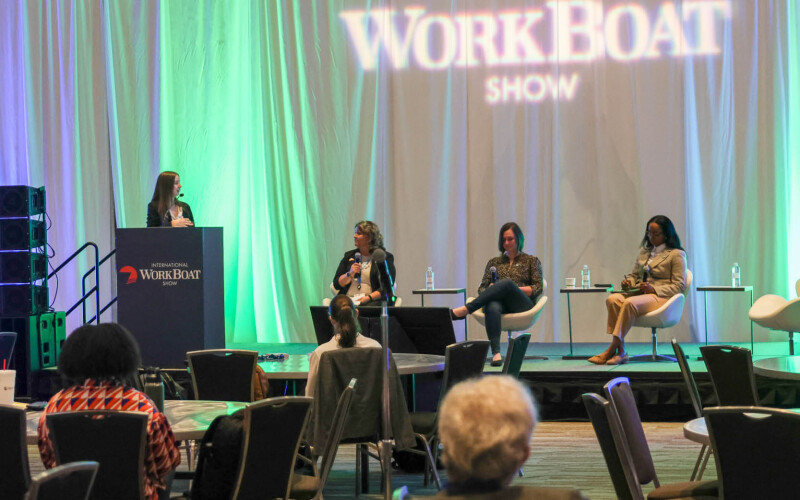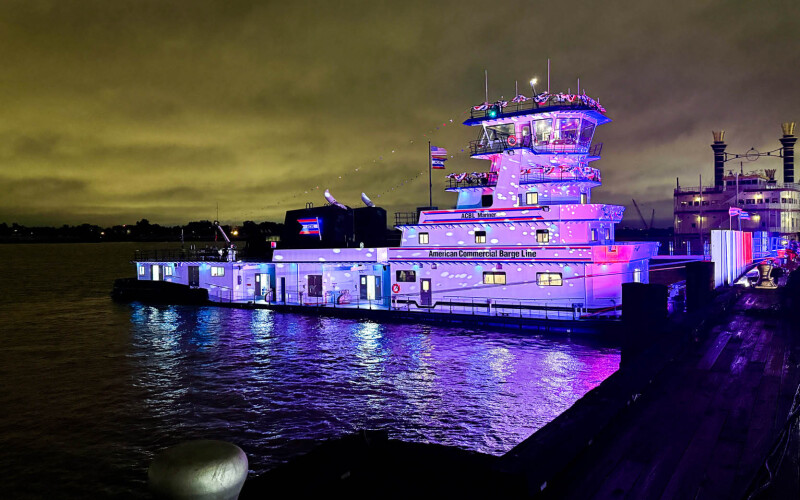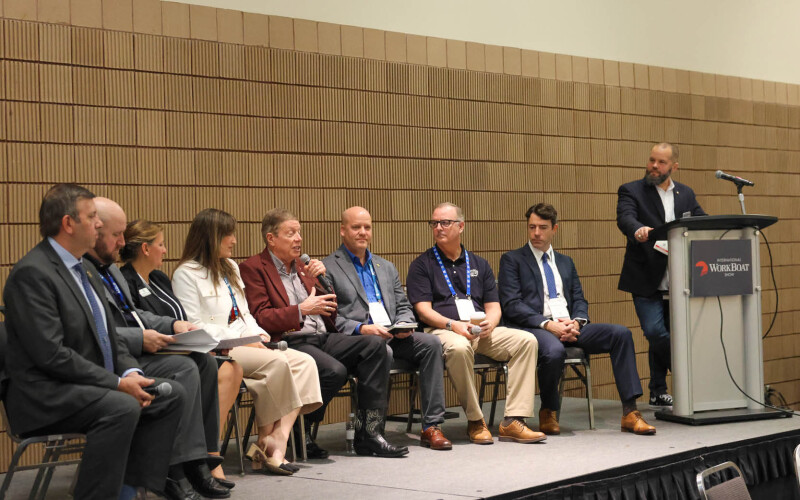The 2024 edition of the International WorkBoat Show (IWBS) was a success. So much so that the 2025 show is expanding.
The show hosted over 1,000 exhibitors and 14,000 attendees.
“The WorkBoat Show continues to expand the horizons of maritime innovation,” said Liz Plizga, president, Diversified Communications, the show’s owner. “That innovation has been taken to the next level this year with over 200 companies that are new to the show, a revitalized conference program, and an exhibit floor with tools and technologies that highlight the true breadth of this sector. The event has become a catalyst for personal and professional development and really shows the transformative power of a trade show to push the boundaries of an entire industry.”
Two new events this year — the Women in Maritime Luncheon and the Jones Act Breakfast — both sold out.
The Conference Program drew large crowds to sessions on the Baltimore Key Bridge allision, the future of shipbuilding, vessel electrification, vessels of the future, and the U.S. dredging boom, among others.
Again, this year, sessions involving the vessel needs of the Coast Guard, Navy, and Army were among the most popular. And this year the National Oceanic and Atmospheric Administration (NOAA) got in on the act and attracted a big crowd.
IWBS will return to its traditional first week of December time slot on the calendar next year. The 2025 International WorkBoat Show is scheduled for Dec. 3-5 at the Morial Convention Center in New Orleans.
Meanwhile, here’s some of what was making news at this year’s IWBS.
The March 26 ship allision and catastrophic collapse of the Francis Scott Key Bridge in Baltimore was a stark revelation of U.S. port vulnerability.
When the 8,600' continuous-truss span came down, killing six workers, it was the end to a “sequence of poor decisions that are just about the hallmark of all disasters,” said Morgan Fanberg, CEO of Glosten, during a panel discussion.
But the weeks that followed were “a testament to all involved who got the Baltimore Harbor back up and running,” said Fanberg, whose Providence, R.I., marine architecture and engineering firm was involved in the recovery operation that had the main channel fully reopened by mid-June.
Outbound from Baltimore for Sri Lanka, the 948' containership Dali experienced electrical failures that triggered an automatic engine shutdown as it approached the bridge over the Patapsco River. The allision left the Dali pinned under the collapsed span and resulted in approximately 50,000 tons of steel debris in the water. The six men who were killed had been working on the bridge when it collapsed.
Two years before, the same kind of unified command response was brought into play after the containership Ever Forward grounded near the Chesapeake Bay bridge, recalled another panelist, William Doyle, a past CEO of the Port of Baltimore and now executive director and CEO of the Dredging Contractors of America.
“That kind of coordination on command and control is critical,” said Doyle.
While the National Transportation Safety Board determined the Dali had experienced power problems before its early morning departure and the bridge allision around 1:30 a.m., the agency has yet to reach conclusions about the accident. An FBI investigation is likewise continuing.
The interim report pointed to maintenance problems and operating conditions of the ship as possibly having affected its electrical systems.
“I don’t doubt that vibration was an issue,” a typical problem in older vessels, said Glosten’s Fanberg. — Kirk Moore
Each year, WorkBoat magazine names its 10 Significant Boats. To be nominated, the newbuild vessels must adhere to a few mandates that include an appearance in WorkBoat’s On the Ways section or as a stand-alone story between December of the previous year to November of the current year.
Then the editors open up the naming of the Boat of the Year to the public via a website created specifically for the occasion.
This year’s winners were Great Lakes Dredge & Dock Corp.’s (GLDD) 99'x41'x12' Multi Cat dredge support vessels, Cape Hatteras and Cape Canaveral, marking the second year in a row that sisterships won the award. The twin Damen 3013 Multi Cats were built by Conrad Shipyard, Morgan City, La.
Main propulsion comes from three Caterpillar 3412D TTA diesel engines, producing a total of 2,500 hp at 1,800 rpm. The mains connect to Promarin fixed-pitch wheels in Optima nozzles through Reintjes WAF 464 marine gears with 5.591:1 ratios.
The propulsion package gives the new Damen Multi Cats a speed of 9.6 knots and a bollard pull of 35 metric tons. For added maneuverability, the multipurpose dredge support vessels feature a 360° hydraulically driven, 310-hp bowthruster.
Ship’s service power comes from two Caterpillar C 04.4 gensets, sparking 107.5 KVA (one KVA is equal to 1,000-volt amps) each. Hydraulic power comes from a Caterpillar 3412D TTA engine producing 632 kW of electrical power.
Cape Hatteras and Cape Canaveral are the first Damen Multi Cats to be built in the U.S. and are fully compliant with Coast Guard and Corps of Engineers stability criteria. — Ben Hayden
The commercial marine industry, like nearly every other sector across the globe, is grappling with its contributions to climate change and the regulations that have recently been developed to try to curb carbon emissions. According to the Department of Energy, the maritime industry is responsible for roughly 3% of total greenhouse gas emissions globally every year.
The idea of embracing further sustainability within the commercial marine industry was the topic of a session entitled “Paving the Way to Sustainable Shipyard and Port Operations.” The panel discussion included professionals who are working on these problems daily. Moderated by Brittney Blokker, program manager, Green Marine, the panel featured Jan Allman, vice present and general manager, Fincantieri Bay Shipbuilding; Emily Federer, sustainability manager, Port of New Orleans; and Jeri Shull, vice president, corporate environmental, Arcosa.
In this mission to bring more sustainable efforts to the industry, Blokker pointed out in the session’s opening remarks that shipyards and ports are target areas for meeting these goals.
“Ports and shipyards are uniquely positioned to combat climate change due to their strategic role in global trade, while also being deeply ingrained in their local community,” she said. “Their capacity to develop infrastructure, adopt cleaner technologies, and engage multiple stakeholders will allow them to drive sustainable initiatives that have both local and global impacts.”
One of the topics discussed was how organizations can begin their journey toward sustainability, an area where Shull has focused due to Arcosa’s relative youth in the industry. The company is still finding its footing, she said, emphasizing that its environmental, social, and governance committees are leading the push to sustainable decision-making, leaning heavily on committees specifically formed to address these issues.
“Our ESG committees, which are built from our executives, our leadership, and our champions across our enterprises,” she said, “are the ones that drive the knowledge throughout our enterprise, understanding what our initiatives are, what we’re trying to do, and build up the knowledge of our personnel.”
For her part, Federer spoke from the perspective of a significantly older organization, with the Port of New Orleans celebrating over 130 years as a recognized marine entity in Louisiana. Even so, Federer said, her company feels relatively new in this area with its ESG program having been established in 2013. — Matt Collins
American Commercial Barge Line (ACBL), Jeffersonville, Ind., christened its new 200'x50'x12'6" towboat Mariner on the Mississippi River in an out-of-the-ordinary nighttime ceremony. ACBL officials said Mariner is the largest towboat built in the U.S. in 50 years.
Constructed by C&C Marine and Repair, Belle Chasse, La., and designed by CT Marine, Edgecomb, Maine, the 11,000-hp boat has an operating draft of 11'6", eight 65-ton winches, dual steering and flanking rudders, and can adjust its operating draft by up to 18" to navigate shallow waters during low-river levels.
The baptism began about 6 p.m. after the close of the first day of the WorkBoat Show. The ceremony took place at Mardi Gras World and featured the traditional breaking of the bottle on the boat’s bow, a lavish fireworks show, and a mini parade, followed by a party to rival an upscale wedding reception.
“Mariner represents all mariners, from the deckhand to our most experienced captain,” ACBL’s CEO Mike Ellis told the crowd. “This boat is not just a vessel. It’s a home” to the mariners who operate it.
Ellis said the contract to build the boat was signed in 2022 with the boat scheduled for delivery in 2025. But during Mariner’s construction, Ellis got a call from Tony Cibilich, C&C Marine’s owner, asking him if ACBL would host a christening party during this year’s WorkBoat Show if C&C Marine delivered the boat in time. There would be no additional cost to ACBL except that Cibilich wanted a big christening party to mark the occasion. Cibilich delivered the boat, and Ellis delivered on the party.
Main propulsion for the Mariner comes from twin Caterpillar C280-12 diesel engines connected to Hung Shin 5-bladed wheels through Reintjes WAF 6755 marine gears supplied by Karl Senner. Steering and controls are the responsibility of CT Marine’s TwinDIFF system.
Within days of the christening, Peter Coxon was named ACBL’s CEO, succeeding Ellis, who had held the position since 2020. — Ken Hocke
Industry leaders gathered for a session to discuss workforce development, one of the most pressing challenges facing the maritime sector. The conversation, which addressed recruitment shortages and explored innovative partnerships, was both forward-thinking and practical, offering valuable insights into how the industry can build a sustainable, skilled workforce.
A recurring theme throughout the session was the need for stronger collaboration between maritime schools, industry leaders, and local communities. “We’re not going to do the thing that we’re trying to accomplish without partners,” said Capt. Elizabeth Simmons, vice president of external affairs at Massachusetts Maritime Academy.
Simmons pointed out that the collective efforts of maritime academies, community colleges, and private companies can create a powerful network to attract, train, and retain talent.
In Houston, this kind of partnership is already showing results. John Stauffer, associate vice chancellor of maritime at San Jacinto College, shared the efforts made to enhance maritime education with cutting-edge technology.
“The Houston Pilots purchased three bridge simulators for us and put them in the college,” he said. “Chevron just adopted nine high schools with maritime programs to go ahead and build up their simulation capabilities.” The simulators are part of a broader initiative to modernize training facilities and give students hands-on experience with the latest equipment. Stauffer emphasized how major industry players are getting involved at the grassroots level.
Another topic that sparked discussion was the role of social media and digital marketing in attracting younger workers. As more students turn to platforms like Instagram, YouTube, and TikTok to discover new career opportunities, maritime institutions are adapting to meet them where they are.
“Our admissions office is using social media to create short video clips about current students talking about why they came, how they found out about maritime, and what they’re looking to do with their careers,” said Simmons.
The approach, which focuses on sharing real student experiences, is proving to be an effective tool in reaching potential recruits, especially those who may not have considered a maritime career previously.
Col. Michael E. Fossum, COO and vice president at Texas A&M Galveston, touched on the importance of using digital tools to not only reach students but also to engage their families. Geo-tracking technology, for example, facilitates monitoring or recording the physical location of individuals in real time. “We’re able to see what the students are interested in as well as where they are located,” Fossum said. The panelists also shared that geo-tracking helps them understand the students’ parents as well. He emphasized that many students first learn about the maritime industry through their parents, making it essential to engage families in the process.
While digital marketing strategies are becoming essential, funding for such initiatives remains a key challenge. Capt. Jeff Spillane, dean of the school of maritime education training at SUNY Maritime College, acknowledged the difficulty many schools face when it comes to securing the resources necessary for outreach. “That’s usually our limiting factor — how do we pay for it?” Spillane asked. “We’re trying to figure out how." — Carli Stewart





